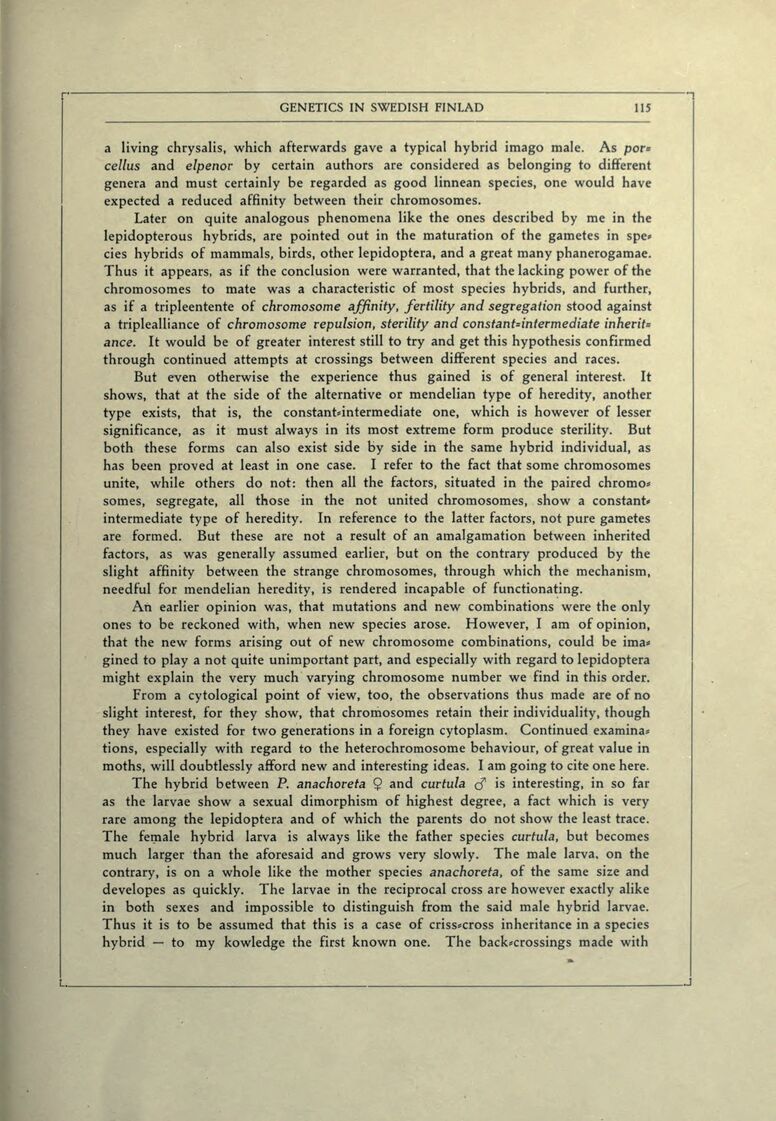
Full resolution (JPEG) - On this page / på denna sida - Part I - Docent Harry Federley, Helsingfors, Genetics in Swedish Finland

<< prev. page << föreg. sida << >> nästa sida >> next page >>
Below is the raw OCR text
from the above scanned image.
Do you see an error? Proofread the page now!
Här nedan syns maskintolkade texten från faksimilbilden ovan.
Ser du något fel? Korrekturläs sidan nu!
This page has never been proofread. / Denna sida har aldrig korrekturlästs.
a living chrysalis, which afterwards gave a typical hybrid imago male. As por»
cellus and elpenor by certain authors are considered as belonging to different
genera and must certainly be regarded as good linnean species, one would have
expected a reduced affinity between their chromosomes.
Later on quite analogous phenomena like the ones described by me in the
lepidopterous hybrids, are pointed out in the maturation of the gametes in spe»
cies hybrids of mammals, birds, other lepidoptera, and a great many phanerogamae.
Thus it appears, as if the conclusion were warranted, that the lacking power of the
chromosomes to mate was a characteristic of most species hybrids, and further,
as if a tripleentente of chromosome affinity, fertility and segregation stood against
a triplealliance of chromosome repulsion, sterility and constanUintermediate inheriU
ance. It would be of greater interest still to try and get this hypothesis confirmed
through continued attempts at crossings between different species and races.
But even otherwise the experience thus gained is of general interest. It
shows, that at the side of the alternative or mendelian type of heredity, another
type exists, that is, the constantdntermediate one, which is however of lesser
significance, as it must always in its most extreme form produce sterility. But
both these forms can also exist side by side in the same hybrid individual, as
has been proved at least in one case. I refer to the faet that some chromosomes
unite, while others do not: then all the factors, situated in the paired chromo»
somes, segregate, all those in the not united chromosomes, show a constant*
intermediate type of heredity. In reference to the latter factors, not pure gametes
are formed. But these are not a result of an amalgamation between inherited
factors, as was generally assumed earlier, but on the contrary produced by the
slight affinity between the strange chromosomes, through which the mechanism,
needful for mendelian heredity, is rendered incapable of funetionating.
An earlier opinion was, that mutations and new combinations were the only
ones to be reckoned with, when new species arose. However, I am of opinion,
that the new forms arising out of new chromosome combinations, could be ima»
gined to play a not quite unimportant part, and especially with regard to lepidoptera
might explain the very mueh varying chromosome number we find in this order.
From a cytological point of view, too, the observations thus made are of no
slight interest, for they show, that chromosomes retain their individuality, though
they have existed for two generations in a foreign cytoplasm. Continued examina»
tions, especially with regard to the heterochromosome behaviour, of great value in
moths, will doubtlessly afford new and interesting ideas. I am going to cite one here.
The hybrid between P. anachoreta 9 and curtula is interesting, in so far
as the larvae show a sexual dimorphism of highest degree, a faet which is very
rare among the lepidoptera and of which the parents do not show the least trace.
The female hybrid larva is always like the father species curtula, but becomes
mueh larger than the aforesaid and grows very slowly. The male larva. on the
contrary, is on a whole like the mother species anachoreta, of the same size and
developes as quickly. The larvae in the reciprocal cross are however exaetly alike
in both sexes and impossible to distinguish from the said male hybrid larvae.
Thus it is to be assumed that this is a case of criss»cross inheritance in a species
hybrid — to my kowledge the first known one. The back»crossings made with
L,
<< prev. page << föreg. sida << >> nästa sida >> next page >>